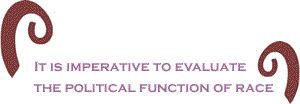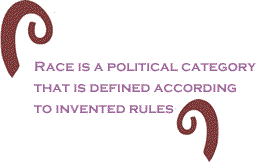|
Dorothy
Roberts’ new book, Fatal
Invention: How Science, Politics, and Big Business Re-create
Race in the Twenty-First Century is a must read for all human beings desiring
to witness the beginning of the end of racism.
is a must read for all human beings desiring
to witness the beginning of the end of racism.
“We have long had scientific confirmation
that race is a political and not a biological category.
The recreation of biological race in genomic science today,
like its invention by scientists in past centuries, results
from an ideological commitment to a false view of humanity,”
writes Roberts.
In 2000, The Human Genome Project
mapped the entire human genetic code, proving that race
could not be identified in our genes, that we are not naturally
divided into genetically identifiable racial groups, that
there is one human race.
Roberts explains and elucidates race
as a political division, not a biological one. And
details how the new science and technology of racial genetics
is threatening “to steer America on a course
of social inhumanity that already has begun to dominate
politics in this century. Government policies that have
drastically slashed social services…accompanied by particularly
brutal forms of regulation of [so-called] racial minorities:
mass imprisonment at rates far exceeding any other place
on Earth or any time in the history of the free world; roundup
and deportation of undocumented immigrants, often tearing
families apart; abuse of children held in juvenile detention
centers or locked up in adult prisons, some for the rest
of their lives;…torture in police stations and prison cells;
and rampant medical neglect that kills.”
In addition to exposing how the biotechnology
and pharmaceutical industries are developing and marketing
products erroneously applied to racial groupings, Roberts
alerts us to our own racist tendencies and false assumptions.
Pointing out how we walk into a crowded room of diverse
individuals and promptly identify “the race of every single
person in that room.”
“Americans are so used to filtering
our impressions of people through a racial lens that we
engage in this exercise automatically – as if we were merely
putting a label on people to match their innate racial identities.
But the only way we know which designation to assign each
person is by referring to the invented rules we have been
taught since we were infants.”
“A biological race is a population
of organisms that can be distinguished from other populations
in the same species based on differences in inherited traits.
There are no human populations with such a high degree of
genetic differentiation that they objectively fall into
races. There is only one human race.”

Quoting a famous geneticist, “Chimpanzees
have races; honeybees have races; we don’t have races.”
“The distinction between the two
meanings of race – as a biological versus a political grouping
– is monumentally important. If race is a natural division
it is easy to dismiss the glaring differences in people’s
welfare as fair and even insurmountable; even liberals could
feel comfortable with the current pace of racial progress,
which leaves huge gaps between white and nonwhite well-being.
But if race is a political system, then we must use political
means to end its harmful impact on our society.” [my
emphasis]

“It is the belief in fundamental
human equality that inspires many people to fight collectively
against racism and its dehumanizing practices. Locating
the causes of inequality in social rather than genetic structure
is liberating because it is much easier to change society
than genes. It is more enlightened to understand the potential
for political alliances apart from biological distinctions
than to believe we are inevitably divided and shackled by
immutable differences programmed in our genes.”
Roberts explodes some of the myths
surrounding slaves and slavery. For example, “The word ‘slave’
comes from Slavs, who were held in bondage from as early
as the ninth century. The ancestors of people now considered
white, who think of themselves as the slaveholding race,
were once held as slaves themselves.”
“Even in the New
World, ‘slave’ did not automatically mean ‘black.” The vast
majority of people compelled to work in the fields of the
American colonies were vagrant children, convicts and indentured
servants shipped from Britain.”
Before the 18th century boom in the
African slave trade, between half and two-thirds of all
white immigrants came as unfree laborers, up to 400,000
Europeans.
Captured Africans, Europeans and
indigenous peoples shared the same status, and worked alongside
each other regardless of color, even forming families together.
They also joined ranks in a series of revolts, and even
the few Africans who gained freedom and purchased land seemed
to have been treated as equals to other landowners. (And,
yes, there were African slave owners.)
“By 1700, however, Africans were
treated as a distinctly different kind of slave: they were
made into the actual property of their masters, a lifelong
bondage that passed down to their children. In contrast,
the status of white indentured servants was neither permanent
nor inherited; whites could work off their bond.”

“As officials split white indenture
from black enslavement and established ‘white,’ ‘Negro,’
and ‘Indian’ as distinct legal categories, race was literally
manufacture by law.”
Whites were subsequently given special
rights over Black slaves: Pass laws restricted the latter’s
movements and poor whites could enforce the laws requiring
public, often naked, beatings of rebellious slaves.
“Christian” came to mean “white,”
and laws were established to protect any Christian from
being attacked by a “negroe or other” slave.
Anti-miscegenation laws outlawed
interracial sex and marriage, “White people were held out
as a privileged race that should be protected from contamination
by inferior races.” Such laws were also used to protect
the property rights and “the great heritage of the white
race.”
Laws prohibiting marriage between
whites and “coloreds” remained until the 1967 Supreme Court
ruling in Loving v. Virginia rendered them unconstitutional
in Virginia and
16 other states. South
Carolina kept its ban until 1998, and even then was opposed
by 38% of voters in the referendum.
The combining of “Africans into a
single race eventually obliterated the physical, linguistic,
and cultural distinctions that had existed among thousands
of ethnic groups on the African continent….W.E.B. DuBois
observed that ‘the discovery of personal whiteness among
the world’s peoples is a very modern thing.’ It was only
with the slave trade, Indian conquests and a legal regime
that installed a racial order that Europeans assumed whiteness
as a personal identity and possession that naturally entitled
them to a privileged social position.”
“It is in this acute distinction
between the political status of whites and blacks…that
we find the origins of race. Colonial landowners inherited
slavery as an ancient practice, but they invented race as
a system of power.”
“There is no test for whiteness.
White means belonging to the group of people who
are entitled to claim white privilege.”

Nevertheless, the medical profession
has “historically promoted a racial construction of disease
that in turn perpetuates a biological construction of race.”
Roberts’ elaboration on the erroneous
application of racial theories in medical treatments and
therapies should be cause for alarm among all people of
color. It reminded me of the racism displayed by doctors
in my medical history. For example, a rheumatologist once
told me I didn’t have to worry about osteoporosis because
I was not a white woman. After changing doctors, a bone
test revealed that indeed I did have osteoporosis, a side
affect of the drug he was administering to me.
Roberts also disavows as “patently
unscientific” the “idea that blacks and whites represent
opposite races.” Noting that Africans and Europeans are
swimming distance apart, “the intimate intertwining of Europeans
and Africans in the ensuing centuries through trade, conquest,
enslavement, and migration make it absurd to consider them
opposites from a genetic standpoint.”
One of the more fascinating chapters
in her book discusses genetic ancestry equated with
geographic ancestry. “Believing in race can be compared
to believing in astrology. People who have faith in astrology
find constant confirmation that horoscope predictions are
reliable and that astrological signs determine personality
types.”
In clarifying the political nature
of our differences, Roberts raises the following questions:
“If races are fixed biological groupings,
how can the test defining who belongs in each group change?....[H]ow
can a judge officially assign (and reassign) it according
to a legal classification system? If race is written in
nature, how can people rewrite the rules?”
The very first U.S. census of 1790 counted the number of persons
in each household according to the following categories:
free white males 16 and older, free white males under 16,
free white females, and all other free persons and slaves.
Since then, census groupings have changed 24 times. And
the 2010 census provides 15 categories as wells as spaces
to write in an identity not listed.
“This classification scheme suggests
that there is one white race, one black race, one American
Indian/Alaska Native race, but an unspecified number of
Asian and Pacific Islander sub-races.

The wave of immigrants from southern
and eastern Europe who arrived between
the 1840s and 1930s were among those subjected to the 1924
exclusionary laws passed by Congress. But they threw off
their customs, names and accents to assimilate and be granted
the privileges of whiteness. Italians, e.g., were
called Guineas,
an epithet originally reserved for Africans from the West
Coast of the continent. Even the Irish were considered to
be closer to Africans than to the English, often caricatured
as apelike and not full members of the white race
100 years ago. More evidence that “race is a political category
that is defined according to invented rules.”
“To this day, the delusion that race
is a biological inheritance rather than a political relationship
leads plenty of intelligent people to make the most ludicrous
statements about black biological traits. Worse yet, this
delusion permits a majority of Americans to live in perfect
comfort with a host of barbaric practices and conditions
that befall blacks primarily – infant deaths at numbers
worse than in developing countries, locking up children
in adult prisons for life, the highest incarceration rate
in the history of the free world – and still view their
country as a bastion of freedom and equality for all.”
In short, “race is the product of
racism; racism is not the product of race.”
Quoting anthropologist Deborah Bolnick,
Roberts notes, “From a genetic perspective, non-Africans
are essentially a subset of Africans.”
Since genetic diversity evolved in
Africa, the continent’s populations vary the most, or have
accumulated more genetic differences than those people who
migrated from Africa and dispersed
throughout the world.
“In fact, the entire range of human
variation for some genetic traits can be found on the African
continent,” writes Roberts. She notes that individuals from
Congo,
Ethiopia,
and South Africa are more genetically
different from each other than from French people. “This
seems astonishing because we are so used to focusing on
a tiny set of physical features, especially skin color,
to assign people to racial categories.”
Crediting anthropologist, Richard
S. Cooper, Roberts explains, “Sub-Saharan Africa is home
to both the tallest (Maasai) and the shortest (pygmies)
people, and dark skin is found in all equatorial populations,
not just in the ‘black race’ as defined in the United States,” and
most genetic variation is found within any human
grouping.
“Perhaps the most compelling evidence
that race is a political category is its instability. Since
its invention to manage the expansion of European enslavement
and the colonization of other peoples, the definitions,
criteria and boundary lines that determine racial categories
have constantly shifted over the course of U.S. history. Who qualifies as white, black and
Indian has been the matter of countless rule changes and
political decisions. These racial reclassifications did
not occur in response to scientific advances in human biology,
but in response to sociopolitical imperatives.”
“When a South Carolina judge declared
in 1835 that ‘a slave cannot be a white man,’ he made clear
that racial identity was not a biological fact that could
be ascertained with scientific proofs, but rather a socially
and legally defined status that rested on a deeper ideological
commitment to race, in which white equaled free (civic,
responsible, manly) and black equaled slave (degraded, irresponsible,
unfit for manly duties).”

“Another set of racial cases involved
litigation over the legal question, Who is white? The Naturalization
Act of 1790…restricted eligibility [for citizenship] to
free white immigrants. Until this racial requirement was
abolished in 1952, being either a ‘white person’ or (after
the Civil War) a person of ‘African nativity or African
descent’ was a prerequisite for becoming a citizen.
The test of whiteness for naturalization
became a vital legal issue for nearly a century. Between
1878 and 1952, state and federal judges issued 52 decisions,
including two before the Supreme Court in the 1920s. “In
these cases, Chinese, Japanese, Koreans, Filipinos, Hawaiians,
Afghanis, Native Americans, and anyone of mixed ancestry
were not white. Arabs, Syrians and Asian Indians were considered
white by some judges and not by others.
“In the wake of the Civil War and
the 14th Amendment, Congress amended the law in 1870 to
extend naturalization to persons of ‘African nativity or
African descent,’ while deliberately denying Chinese immigrants
that right on the grounds they posed a risk to American
morals and jobs.”
“Congress moved more directly to
stanch the ‘Mongolian invasion’ with the Chinese Immigration
Act of 1882, barring entry to Chinese workers for 10 years,
including the wives and families of immigrants already in
the country. Subsequent laws passed in 1917, 1924, and 1934
extended the exclusion to immigrants from Japan,
India,
and to the Philippines. The
supposedly biological category ‘Asian’ commonly employed
today was solidified by the series of statutes and court
decisions that classified immigrants from each nation as
nonwhite. The racial question was ultimately a political
question about which groups the federal government deemed
qualified for citizenship. Ironically, a Texas
judge bestowed white status on Mexicans.
“The infamous one-drop rule, passed
in Tennessee in
1910…defined a person as Negro if he or she had…one drop
of Negro blood.
A “reverse one-drop rule” (i.e.,
one white ancestor) applied to Mexicans, permitted them
to assume the privileged whiteness.
While these classifications remind
us that these racial categories and institutionalized inequities
are not natural, when “Americans see black and brown people
doing most of the menial jobs, dying younger from most diseases,
and filling most of the prison cells, it’s easy for many
to see race and believe it must be part of nature.”
Finally, Roberts asked the question
I had asked myself when I first learned of the Human Genome
Project breakthrough in 2000: “Why, then, do most Americans
cling to a false belief that biological races really do
exist? Why do they latch on to whatever trivial proof they
can muster to confirm their misconceptions about race?
“Children in the U.S. learn to divide all people into racial groups
and come to have faith in race as a self-evident truth,
like a traditional creation story that explains how the
world works.”
“Racism is a faith,” noted George
B. Kelsey (who mentored Dr. Martin Luther King Jr.). Roberts
continues: “It is the faith in race – the religion of separating
human beings into racial groups – that makes it difficult
for Americans to think like scientists.”

“Race persists because it continues
to be politically useful. It is therefore imperative
to evaluate the political function of race at the present
time and wage a political assault against it.”
In conclusion, I’m most grateful
to Dorothy Roberts for writing this book from which I’ve
learned so much. My criticisms are: 1) I felt as if she
were addressing her academic colleagues, not the general
public, making it a difficult, albeit worthwhile, read.
2) As she elucidates the social construction of race, some
of her language still reflects old paradigms and ideas,
including the use of nonwhite, mulatto, and racial
minorities. If we are equally human beings, then no
one group should be referred to as a minority. Even as she
points out that whites are about 35% of New York City’s population, she fails to note that
whites are a minority. In California, it’s long been established that “people of color” are the
majority, yet one never hears whites referred to as a minority.
Obviously, whites are loathe to call themselves “inferior
in importance” or less than (Webster).
In lieu of this timely contribution
to our understanding of race and racism, it’s my hope that
we will begin to change our language to reflect the new
reality. For example, we can stop using races, substituting
ethnicities or nationalities. We can stop calling people
minorities, and we can begin to re-examine our own
attitudes, prejudices, and beliefs with the idea in mind
of one human race. One step at a time, we must begin to
eliminate race as a category as we move toward a planet
of peace and harmony.

BlackCommentator.com Guest Commentator, Kiilu Nyasha, is a San Francisco-based journalist
and former member of the Black Panther Party. Through the
end of 2009, Kiilu hosted a weekly TV program, “Freedom
Is A Constant Struggle,” on SF Live, and many shows are
archived on her website. Kiilu writes for several publications, including
the SF Bay View Newspaper, and is also an accomplished radio
programmer. She has worked for KPFA (Berkeley), SF Liberation
Radio, Free Radio Berkeley, and KPOO in San
Francisco. Click here
to contact Ms. Nyasha.
|

